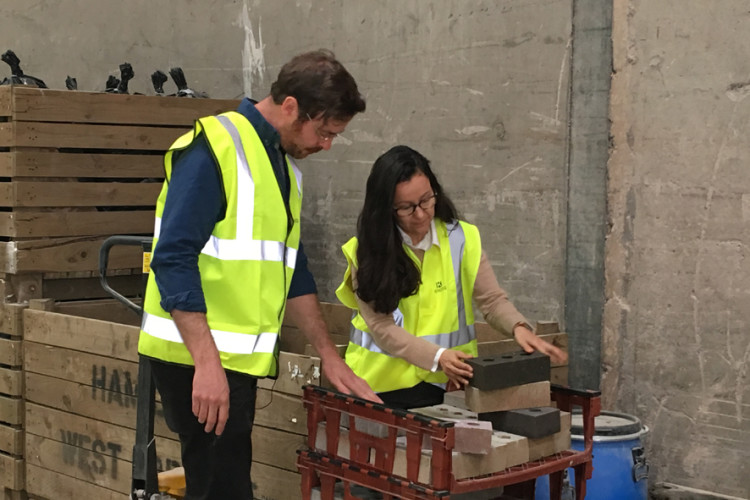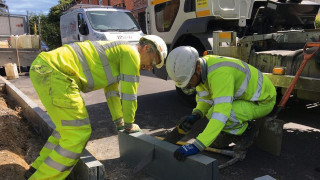“You can’t make bricks without straw,” goes the old saying. Nonsense – of course you can. In fact you can even make bricks without clay, and that’s far more impressive.
Scientists at Edinburgh’s Heriot-Watt University have developed a brick that is made from finely-ground demolition waste, recycled plasterboard and a special binding compound that remains a closely-guarded secret.
The product doesn’t need to be fired in a kiln and it doesn’t contain any cementitious compounds. And yet it is said to rival traditional fired clay bricks for strength, possess better thermal resistance and have just one-tenth of the traditional product’s carbon footprint.
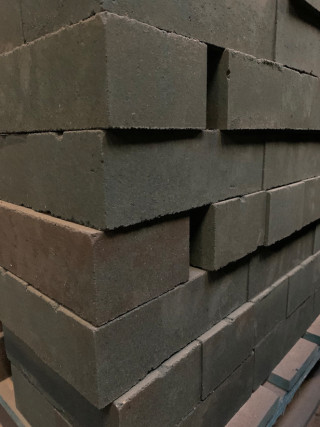
Called the K-Briq, the new product is the result of 10 years of research and development by Gabriella Medero, professor of civil engineering at Heriot-Watt University, and is the culmination of her quest to find a low-carbon, recyclable alternative to the traditional clay brick.
“I have spent many years researching building materials and have been concerned that modern construction techniques exploit raw materials without considering that they are amongst the largest contributors to carbon emissions,” explains Medero. “The amount of waste they produce is not sustainable long-term,” she adds.
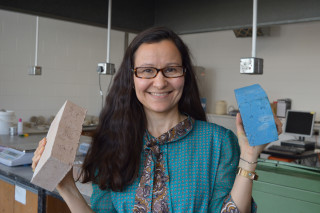
The K-Briq looks like a normal brick, weighs the same amount and behaves like a clay brick but with better insulation properties, says Medero. “It is sustainable and not kiln-fired so it is far better for the environment and represents massive savings for the construction industry in terms of related taxes.”
In fact, Medero claims that the K-Briq contains 90% recycled material – the highest of any building material in the UK. When you consider that every year the UK consumes approximately two billion bricks and sends an estimated six million tonnes of construction waste to landfill, a brick made from recycled waste clearly has a lot to offer.
Demolition waste is, of course, already processed and reused extensively as an ingredient in concrete mixes and as an alternative to quarried aggregate as a Type 1 fill. But Medero says she wanted to add value to the waste product:
“It bothered me that the construction sector generated so much waste and I wanted to look at how I could develop a better use for it than just as filler,” she says.
Crushed demolition waste could be used to produce concrete bricks – and indeed concrete bricks and blocks are nothing new at all. But although these products don’t need to be fired in a kiln, the cement needed to make them is one of the most carbon-intensive products in existence. The cement industry accounts for approximately 8% of all global carbon emissions and if the industry were a country, it would be the third-largest emitter of CO2 after China and the US.
So there’s no cement in a K-Briq. But ask Medero what goes into it and how it’s made and she’s giving nothing away – that’s all commercially sensitive and patent-protected, she declares. Nevertheless, a piece about the new product broadcast on BBC Television’s The One Show last month showed the raw materials being tipped into a hopper and packed into moulds before being spat out in the shape of finished bricks “in minutes”.
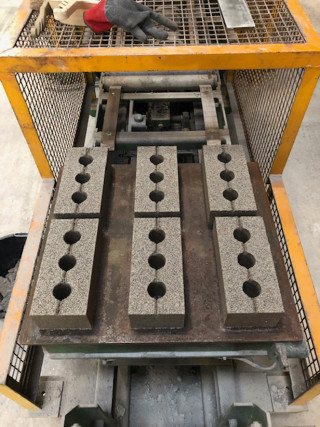
Really? “Yes, just minutes,” confirms Medero. From receiving an order to packaging and shipping out to customers, the production process takes just 24 hours, she says.
Having completed her research and perfected the product, Medero’s next step was to get the K-Briq into production which she has now done in partnership with one of her former students, Dr Sam Chapman.
“I first studied structural engineering as one of Gaby’s students and then came back to Heriot-Watt to do my PhD, which was in the carbon assessment of wind power plants,” explains Chapman. “Gaby asked me if I could carry out a carbon assessment of her new brick, and that’s how I became involved,” he adds.
Together, the two scientists set up Kenoteq, a spin-off company co-located at the East Lothian yard of specialist firm Hamilton Waste & Recycling. Here, Kenoteq has its raw material supply on tap, further reducing its carbon footprint by minimising the transport miles and carbon emissions.
Funding for the new company has been provided by a number of bodies, including Zero Waste Scotland, Scottish Enterprise, Construction Scotland Innovation Centre and the Royal Academy of Engineering via an Enterprise Fellowship awarded to Chapman.
“Kenoteq has invested in machinery that can produce three million bricks per year,” says Chapman. “In the past year, we’ve produced thousands of bricks and put them through rigorous testing with the K-Briq now commercially available to construction clients.”
Chapman says Kenoteq’s priority now is to get the product out into the market and he is actively seeking to develop partnerships across the supply chain, from architects right through to product distributors and waste companies.
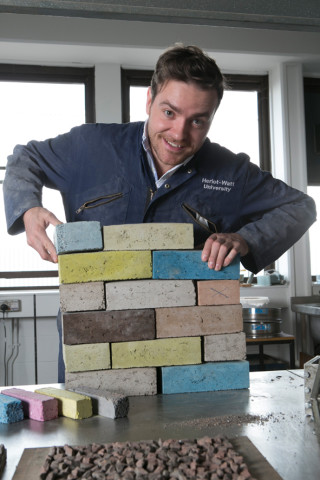
Feedback so far has been encouraging and Chapman says that architects, social housing providers, house-builders and self-builders have all shown an interest. “We’re looking for high-impact projects to demonstrate the K-Briq,” he says, adding that “a few things are imminent”.
Scotland itself offers plenty of potential for Kenoteq, says Chapman, since very few traditional bricks are produced there – around 85% of all the bricks used in Scotland are imported from England or continental Europe. A sustainable home-grown alternative is bound to be attractive.
“The Scottish government has set very high targets for housebuilding with 50,000 new homes earmarked for construction in the next three years,” observes Chapman. “We hope Kenoteq will be part of those homes.”
Meanwhile, at De Montfort University…
While Prof Medero and Dr Chapman were perfecting the K-Briq up at Heriot-Watt, a research team at Leicester’s De Montfort University (DMU) has also been working on an alternative brick product made from waste material.
Last November the team, led by Dr Karthikeyan Kandan, a senior lecturer in mechanical engineering at DMU, unveiled a brick made from recycled domestic plastic waste using 3D printing and lattice architecture technologies.
Dr Kandan says that the design, which boasts excellent thermal insulating properties, was inspired by the structure of the Baya weaver bird’s nest which has an elaborately woven construction.
“The Bayer weaver bird’s nest’s ingenious construction gives it excellent thermal insulation and mechanical properties for inhabitation,” explains Kandan.
“Inside there is a central nesting chamber, which makes it the ideal micro-climate for habitation. By replicating this structure, we have manufactured a brick that improves energy efficiency of modern buildings and therefore can reduce carbon footprint.”
Saad Alqahtani, a first-year PhD student at DMU, carried out controlled experiments on the plastic bricks, under joint supervision from Kandan and his colleague Dr Farukh Farukh – also a senior lecturer in mechanical engineering at the university.
.png)
To test its thermal insulation characteristics, Alqahtani placed the brick in a hot-box calorimeter – a piece of equipment used to measure the U-value of an object, which can be set up to simulate the regulatory standard for buildings.
The results showed a U-value of 0.25W/m2K, making it 10 times more effective than a clay brick, which delivers an average of 2.94 W/m2K.
“Our brick, made from all kinds of domestic plastic waste – from coffee cup lids to plastic bottles – exhibits a tremendous thermal envelope over conventional building materials,” says Kandan. “This provides significant potential to not only improve the energy efficiency of modern building, but also to conserve space and reduce dead-weight in multi-storey buildings.”
Alqahtani adds: “Our work has demonstrated that 3D-printed bricks made from household plastic waste are thermally far superior than the existing bricks made in the market. This breakthrough can literally help us build the future.”
Bricks made of thin air?
A Cambridge-based start-up company is claiming to have developed a process that removes carbon dioxide from the atmosphere and converts it into a substitute building material.
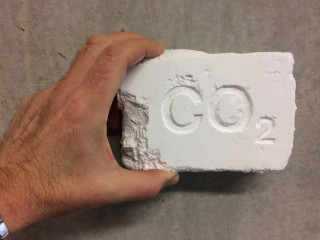
The company, Cambridge Carbon Capture, says that after years of development it has proven its technology at laboratory scale and is now in talks to scale it up.
Its patented CO2LOC technology captures CO2 and converts it into magnesium carbonate to create a substance that can be used either as a direct replacement for gypsum or as a filler in other construction products.
The scientists say that their product is strong and lightweight, extremely resistant to fire and water and has many potential applications across the construction industry.
Its fire-resistant properties mean that even a thin wall of the material can provide superior fire protection for buildings, and it can also be used as an eco-friendly alternative to concrete fillers, blocks, tiles and plasterboard, it is claimed.
The technology works via a two-stage mineralisation process, which involves the reaction of magnesium hydroxide (MgOH2) with CO2 to produce magnesium carbonate (MgCO3).
The magnesium carbonate is filtered out and sets to form a rock-like substance, permanently storing the sequestered carbon in a solid form.
Chief executive Michael Evans said: “Each year, the world produces 40 billion tonnes of CO2. The current goal is for this to be reduced to zero by 2050 – but we are fast running out of time, as the detrimental effects of climate change become more and more apparent every year. The construction sector is a big contributor to CO2 emissions, and we want to help the industry become a lot cleaner.
“Cambridge Carbon Capture offers a unique solution because it allows industry to continue to operate, but any carbon emitted can be captured and converted into a useful by-product which can either be used to displace other more carbon-intensive construction materials or can be sold on for a profit.
“For example, a cement works could capture the CO2 emitted from the cement plant and, using our process, can transform the captured CO2 into a filler in their ready-mix concrete – it really is that versatile,” says Evans, who adds that the technology “takes the concept of a circular economy to a whole new level”.
Having proved the technology in the laboratory, Cambridge Carbon Capture now aims to prove it on an industrial scale. “For that, we need the construction sector to get on board and adopt some of the materials we’re developing, think innovatively and try something new,” says Evans.
The company is now in discussion with a range of organisations to establish partnerships for use of the technology and is seeking investment to enable demonstrations in real-world applications.
“We are also developing a larger demonstrator, housed in a shipping container, which will enable us to trial our technology at all kinds of industrial sites, such as cement works, steel mills and power stations,” Evans says.
Cambridge Carbon Capture developed the technology with the help of a number of Innovate UK grants and worked with the universities of Cambridge and Sheffield to demonstrate its application at a lab scale. The company has since received two further Innovate UK grants to develop its containerised demonstrator.
Plastic kerbs save the planet – and your back
Widespread concern over the accumulation of plastic waste is stimulating research into ways of reusing and recycling post-consumer plastic. And one idea that has already caught on in the construction sector is the recycled plastic kerb.
Late last year, contractor Skanska announced that it was trialling the use of the product, called Durakerb, on its Hampshire County Council highways maintenance contract.
Shortly afterwards, Wokingham Borough Council confirmed that its highways contractor, Volker Highways, would be installing the product at three locations in the borough.
The Durakerb, produced by Econpro Group, is made using 88% recycled material. Each kerb contains the equivalent of 182 recycled plastic bottles and, being made from plastic rather than concrete, weighs only 6kg.
Launched more than 10 years ago, the product has already been used by other highways authorities including Cumbria, North Yorkshire, Tameside and Caerphilly.
Skanska operations director Matthew Riches said: “These plastic kerbs have been BBA/HAPAS approved, meaning they are manufactured to the highest standards for the Hampshire network. With its lightweight features, we can lay four times faster than traditional methods and that’s significant as we look to find ways to deliver a greener, more cost-effective service.”
A traditional concrete kerbstone can be more than 90% heavier than the Durakerb and will emit 40% more CO2 into the atmosphere during manufacture, says Econpro.
The lightweight Durakerb is not only easier and safer to handle, but it can also be cut easily with a handsaw without releasing harmful crystalline silica dust into the atmosphere.
This article was first published in the February 2020 issue of The Construction Index magazine.
UK readers can have their own copy of the magazine, in real paper, posted through their letterbox each month by taking out an annual subscription for just £50 a year. Click for details.
Got a story? Email news@theconstructionindex.co.uk

